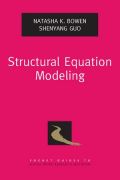
Richly illustrated with figures, equations, matrices, and tables, this pocket guide empowers social workers with a set of defensible analysis strategies that allows for competent, confident use of SEM. Structural Equation Modeling (SEM) has long been used in social work research, but the writing on the topic is typically fragmented and highly technical. This pocket guide fills a major gap in the literature by providing social work researchers and doctoral students with an accessible synthesis. The authors demonstrate two SEM programs withdistinct user interfaces and capabilities (Amos and Mplus) with enough specificity that readers can conduct their own analyses withoutconsulting additional resources. Examples from social work literature highlight best practices for the specification, estimation, interpretation, and modification of structural equation models. Unlike most sources on SEM, this book provides clear guidelines on how to evaluate SEM output and how to proceedwhen model fit is not acceptable.Oftentimes, confirmatory factor analysis and general structure modeling are the most flexible, powerful, and appropriate choices for social work data. Richly illustrated with figures, equations, matrices, and tables, this pocket guide empowers social workers with a set of defensible analysis strategies that allows for competent, confident use of SEM. INDICE: 1. Introduction to the Topic 2. Structural Equation Modeling Concepts 3. Preparing for an SEM Analysis 4. Measurement Models 5. General Structural Equation Models 6. Evaluating and Improving CFA and General Structural Models 7. Advanced Topics 8. Become a Skillful and Critical Researcher Glossary Appendix References Index
- ISBN: 978-0-19-536762-1
- Editorial: Oxford University
- Encuadernacion: Rústica
- Páginas: 264
- Fecha Publicación: 13/10/2011
- Nº Volúmenes: 1
- Idioma: Inglés
